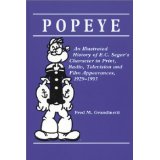
It would be grand if there was a book to serve as a companion piece to the DVD release of Fleischer Studios' Popeye cartoons. Thus far, however, I've been able to find only one such book, and it is very uneven.
Fred M. Grandinetti's 1994 Popeye "biography" has the windy subtitle, An Illustrated History of E.C. Segar's Character in Print, Radio, Television and Film Appearances, 1929-1992. Despite Grandinetti's apparent view of his book as a definitive study, the book is worth at least one read but is decidedly hit-and-miss.
The book begins with the one-eyed sailor's origins as the star creation of Elzie Segar's comic strip "Thimble Theatre" and goes on to detail Popeye's comic-strip adventures to the present day, where it is now several generations removed from Segar, who died in the late '30s. It's a quandary, to be sure: Keep Popeye in his '30s style, and the cartoon gets as dated as "Blondie." Yet when a cartoonist named Bobby London (who did a raunchy comic titled "Dirty Duck" for National Lampoon and Playboy) tried to use Popeye to satirize the greedy merchandising efforts of King Features Syndicate (the Hearst-based company that owns the rights to Popeye's print persona), London's efforts came off as crude, and he was ousted from the strip.
The heart of Popeye's reputation comes from his theatrical cartoons, and when the book concentrates on that era, it is a solid hit. The book lovingly details the Fleischers' groundbreaking animation and terrific humor, and it shows how the cartoons steadily deteriorated after Paramount (the Fleischers' distributor) took over the cartoons from the Fleischers in 1942 and continued doing them theatrically (as Famous Studios) until 1957. It was in this period that the formula got predictable and stale, with the constant plot of Popeye having to rescue Olive Oyl from the clutches of id-ruled Bluto.
When TV started running the old cartoons in the 1950's, demand for Popeye cartoons continued even after the theatrical cartoons ceased. So King Features ground out made-for-TV Popeyes with far inferior budgets, animation, and imagination. It is at this point that the book wears thin as well. The book devotes as much attention to the TV cheapies as it does to the Fleischer/Paramount work, when even a casual glance at the TV cartoons makes clear that they're not worth the effort.
The book goes on to detail Popeye's continued popularity in the late 1970's and early '80s, going into similarly grand detail about the middling Hanna-Barbera TV version of Popeye and his print and ad "guest appearances." The most interesting part of this latter-day section is Grandinetti's account of Robert Altman's disastrous 1980 musical version of Popeye featuring Robin Williams in his first starring movie role. I confess I haven't seen the movie, and judging from its ghastly reviews, I have no desire to do so. So it was interesting to read the synopsis of the movie -- which goes haywire right at the start by declaring that Popeye doesn’t like spinach -- and the subsequent, on-target parody of the movie by MAD magazine.
My biggest quarrel with the book is that for everything it does right, it does two things wrong. The book reiterates its biggest error by giving a detailed synopsis of every Popeye cartoon to date, including the lousy TV versions, which no one will give even a first glance after being treated to the Fleischer gems on DVD. It also, pointlessly, prints a few "scripts" from the cartoons (again, including the TV versions) which are really only dialogue transcriptions that in no way enlighten us as to the lengthy animation process.
On the basis of its spinach-like strengths, Grandinetti's book is worth flipping through at least once, to get to the good stuff. After that, the Fleischer DVDs are more likely to remain a constant on your shelf than is this book.
My rating:


© 2007, Steve Bailey.
Related link:
Animation Insider's interview with Fred M. GrandinettiClick here to go to:
Our cartoon-list page